

| Nottinghamshire Shieldbugs | ||
| .. |
| Shieldbugs belong to the
invertebrate order Hemiptera. They are
characteristic and immediately identifiable bugs, named
after their heraldic shield-like shape. Frequent
in most habitat types, some species are carnivorous, but
most feed on sap sucked from foliage and berries etc.
Most species are not problematical to gardeners or
commercial plant growers. Like all other plant bugs, there are several stages of growth called nymphs, which are often as frequently seen as the adults and a few species are known to exhibit brood care. Nottinghamshire species As far as we can trace, a total of 23 species have now occurred in VC56 Nottinghamshire. But if the record of five Southern Green Shieldbug Nezara viridula (Linnaeus, 1758) from Rufford in September 2017 ever proves to be substantiated, then the county total would be approximately 24 species. Of those species definitely known to have occurred in the county, 23 of them are now illustrated here. The Sand-runner Shieldbug (Sciocoris cursitans) remains the one species not illustrated. This species has been recorded once during an invertebrate survey of Sherwood Heath SSSI in 2006, but our own searches for it there have continually proved fruitless. |
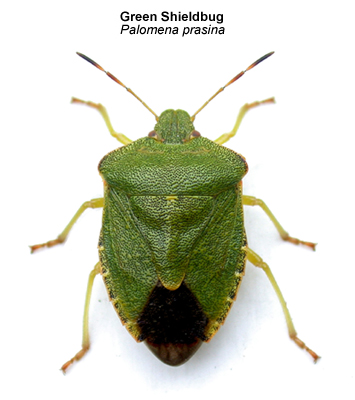 |
|
| .. | ||
| Its a similar situation
to that of the Juniper Shieldbug a few years ago (for
many years was restricted to a just single record) but
which has subsequently proved to be more widespread than
was previously thought. We hope that the same state of
affairs will eventually happen with Sciocoris
cursitans. From our own records accumulated over the past decade or so, the black Shieldbugs Legnotus limbosus, Sehirus luctuosus and especially Thyreocoris scarabaeoides, are probably the most difficult to find in the county. Sweeping the correct vegetation type will help and is probably the best way to find them. Nottinghamshire's larger and more common species should all present no real problem to find if looked for, as most people will probably have come across at least two species in their own gardens. Common Green Shieldbug and the Hawthorn Shieldbug, are the two species most likely to turn up in well vegetated gardens, but others such as Hairy Shieldbug and Birch Shieldbug can occasionally occur. |
| .. |
| A current checklist of Nottinghamshire Shieldbugs |
| .. |
| ACANTHOSOMATIDAE |
| ACANTHOSOMA Curtis, 1824 |
| Acanthosoma haemorrhoidale (Linnaeus, 1758) Hawthorn Shieldbug |
| .. |
| CYPHOSTETHUS Fieber, 1860 |
| Cyphostethus tristriatus (Fabricius, 1787) Juniper Shieldbug |
| .. |
| ELASMOSTETHUS Fieber, 1860 |
| Elasmostethus interstinctus (Linnaeus, 1758) Birch Shieldbug |
| .. |
| ELASMUCHA Stål, 1864 |
| Elasmucha grisea (Linnaeus, 1758) Parent Bug |
| .. |
| SCUTELLERIDAE |
| EURYGASTER Laporte, 1833 |
| Eurygaster testudinaria (Geoffroy, 1785) Tortoise Bug |
| .. |
| CYDNIDAE |
| LEGNOTUS Schiødte, 1848 |
| Legnotus limbosus (Geoffroy, 1785) Bordered Shieldbug |
| .. |
| SEHIRUS Amyot & Serville, 1843 |
| Sehirus luctuosus (Mulsant & Rey, 1866) Forget-me-not Shieldbug |
| .. |
| TRITOMEGAS Amyot & Serville, 1943 |
| Tritomegas bicolor (Linnaeus, 1758) Pied Shieldbug |
| .. |
| PENTATOMIDAE |
| AELIA Fabricius, 1803 |
| Aelia acuminata (Linnaeus, 1758) Bishop's Mitre |
| .. |
| DOLYCORIS Mulsant & Rey, 1866 |
| Dolycoris baccarum (Linnaeus, 1758) Hairy Shieldbug (formerly Sloe Bug) |
| .. |
| EURYDEMA Laporte, 1832 |
| Eurydema oleracea (Linnaeus, 1758) Brassica Bug |
| .. |
| EYSARCORIS Hahn, 1834 |
| Eysarcoris venustissimus (Schrank, 1776) Woundwort Shieldbug |
| .. |
| NEOTTIGLOSSA Kirby, 1837 |
| Neottiglossa pusilla (Gmelin, 1790) Small Grass Shieldbug |
| .. |
| PALOMENA Mulsant & Rey, 1866 |
| Palomena prasina (Linnaeus, 1761) Common Green Shieldbug (formerly Green Shieldbug) |
| .. |
| PENTATOMA Oliver, 1789 |
| Pentatoma rufipes (Linnaeus, 1758) Red-legged Shieldbug (formerly Forest Bug) |
| .. |
| PICROMERUS Amyot & Serville, 1943 |
| Picromerus bidens (Linnaeus, 1758) Spiked Shieldbug |
| .. |
| PIEZODORUS Fieber, 1860 |
| Piezodorus lituratus (Fabricius, 1794) Gorse Shieldbug |
| .. |
| PODOPS Laporte, 1832 |
| Podops inuncta (Fabricius, 1775) Turtle Shieldbug |
| .. |
| RHACOGNATUS Fieber, 1860 |
| Rhacognathus punctatus (Linnaeus, 1758) Heather Bug |
| .. |
| SCIOCORIS Fallén, 1829 |
| Sciocoris cursitans Fabricius, 1794 Sand-runner Shieldbug |
| .. |
| TROILUS Stål, 1867 |
| Troilus luridus (Fabricius, 1775) Bronze Shieldbug |
| .. |
| ZICRONA Amyot & Serville, 1943 |
| Zicrona caerulea (Linnaeus, 1758) Blue Shieldbug |
| .. |
| THYREOCORIDAE |
| THYREOCORIS Schrank, 1801 |
| Thyreocoris scarabaeoides (Linnaeus, 1758) Scarab Shieldbug (formerly Negro Bug) |
| Species
photographs Included in the following species photographs is Rambur's Pied Shieldbug, which is still unknown away from the south-east of the UK, but is one of a number of species likely to expand their range further north. |
| Family :
Acanthosomatidae |
| .. |
| Family : Cydnidae ...... |
| .. |
| Bordered
Shieldbug Legnotus
limbosus (Geoffroy, 1785) |
||
| Another small species, possibly under-recorded in Nottinghamshire, but could also be quite scarce and only found in heathland sites around the Sherwood Forest area. Our only records have both come from Sherwood Forest Country Park, the first being found at the top of a grass blade in an area of grassy heathland in May 2009 and then on the wall of one of the visitor centre buildings in June 2012. The Bordered Shieldbug is found on Bedstraws growing on dry, sandy soils. Occurs in the adult state throughout the year. | ||
| ...... | ||
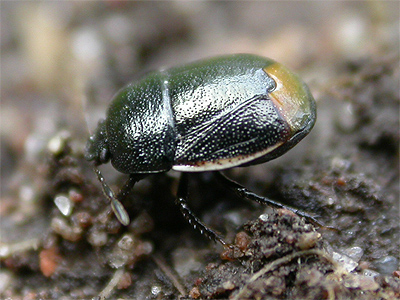 |
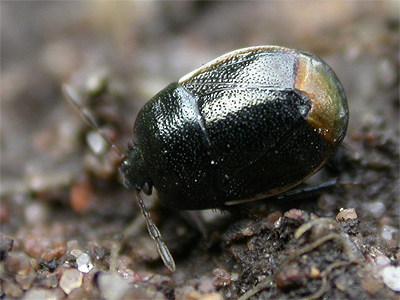 |
|
| Forget-me-not
Shieldbug Sehirus
luctuosus (Mulsant & Rey, 1866) |
||
| This seems to be a rare Shieldbug in Nottinghamshire and as far as we are aware, there are just three known sites where it has occurred. It was first recorded in Nottinghamshire from Warsop Main Pit Top in 2007 (Pendleton, T.A. and Pendleton, D.T.), followed by two records from a brownfield site at Langar in 2015, but adults have occurred each Spring in a Toton garden since 2008 (Lygo, B.). As it's name suggests, it is associated with Forget-me-not and adults occur from August and over-winter. | ||
| ...... | ||
..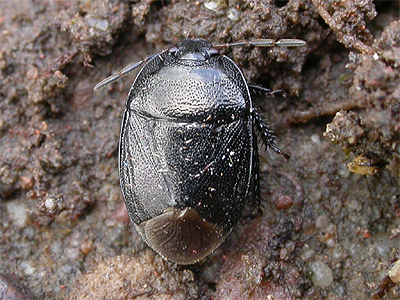 |
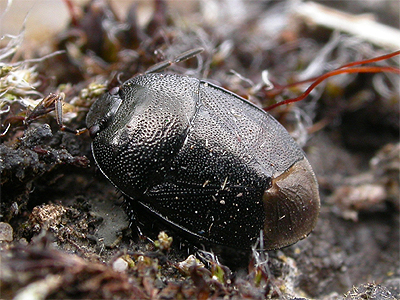 |
|
| Family : Pentatomidae |
| .. |
| Brassica
Shieldbug Eurydema
oleracea (Linnaeus, 1758) |
||||
| This attractive Shieldbug had been spreading steadily north from southern counties of the UK and eventually reached Nottinghamshire in May 2019, when found at Colwick Racecourse and Colwick CP (Matthews, D.), with a further record from Toton in late June (Lygo, B.). The northerly range expansion seems to have increased in 2019, as there were further records from Kirkby Moor in Lincolnshire (Gray, M.) and one from just over the Nottinghamshire border in South Yorkshire (Batty, S.) at the same time as the Colwick record. Adults come in several colour forms, where the white markings can be either red or yellow. Found on Brassicas such as Garlic Mustard and Horse Radish. Recorded from Center Parcs (Hill, M.) and Sherwood Forest CP in May 2020. | ||||
| ...... | ||||
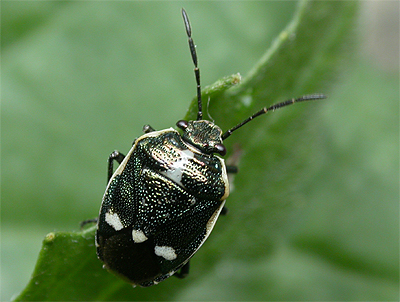 |
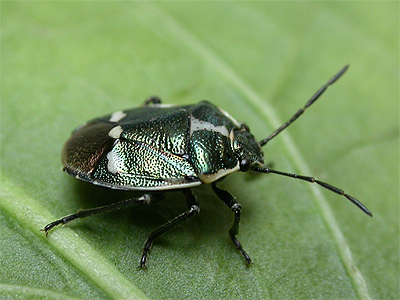 |
|||
| Turtle
Shieldbug Podops
inuncta (Fabricius, 1775) |
||||
| This small, brown and
inconspicuous Shieldbug is still a rare find in Nottinghamshire, but the
number of county records have increased. Nottinghamshire's first record
of Podops inuncta seems to be from Bentinck Banks in 2007 (Kirby, P.), followed by records from Gedling CP in May 2013 (Flanagan, J.), North Muskham in March 2022 and from Gunhorpe in 2023
(both Pendleton, T.A.). It should continue to turn up at other
Nottinghamshire sites in the
future. Podops inuncta (the Turtle Shieldbug is a ground dwelling species and not often found unless specifically looked for. The Gunthorpe record came from a leaf litter sample taken from underneath a single large Sallow in rough grassland and the North Muskham record, was from under a large piece of wood on the bank of the River Trent. There are several very similar species, but identification is made easier by the two projections on the pronotum, located either side of the eyes on this species. |
||||
| ...... | ||||
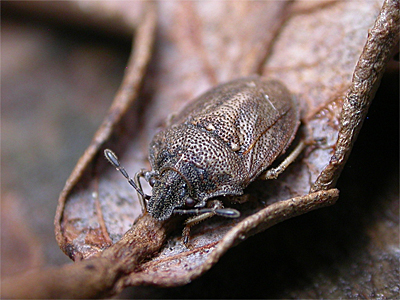 |
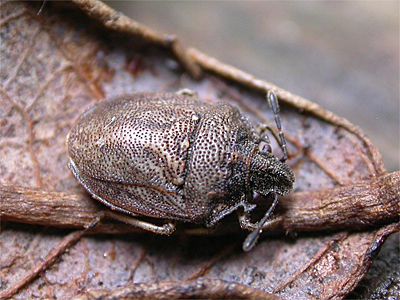 |
|||
| Blue
Shieldbug
Zicrona
caerulea (Linnaeus, 1758) |
||||
| A beautiful Shieldbug, this is fairly widespread in Nottinghamshire, but never encountered in any numbers. The metallic blue colouration makes the Blue Shieldbug easy to identify. It is found on low vegetation, usually along woodland rides and well vegetated habitats. This Shieldbug is predatory, feeding on a wide range of insects. | ||||
| ...... | ||||
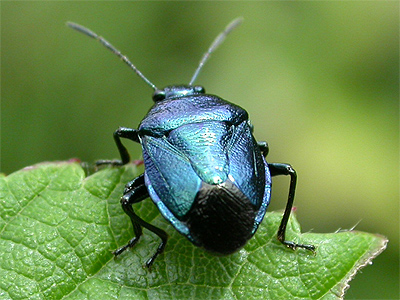 |
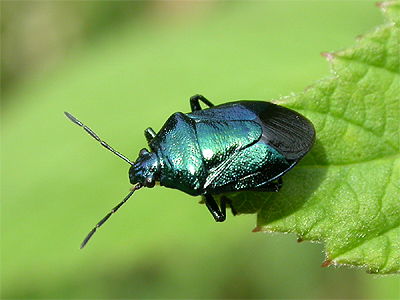 |
|||
| ...... | ||||
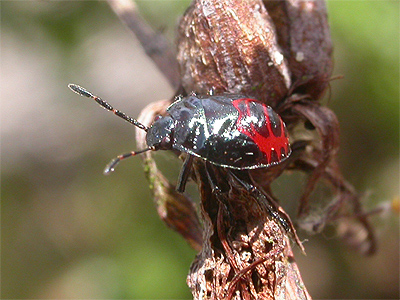 |
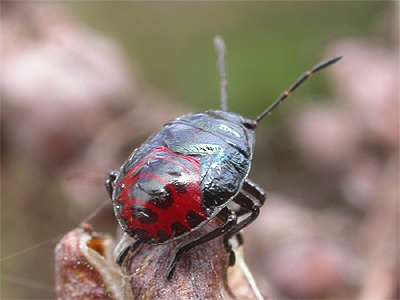 |
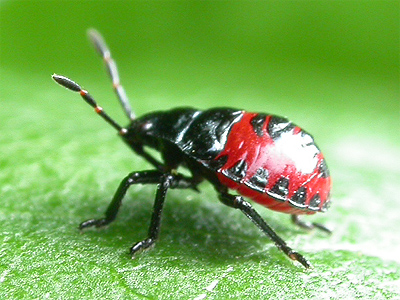 |
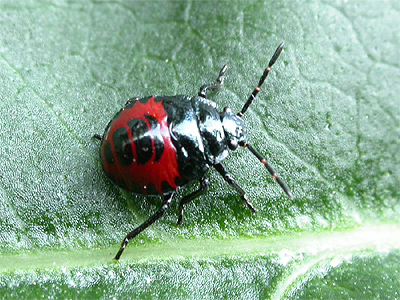 |
|
| Family : Thyreocoridae |
| .. |
| Scarab
Shieldbug Thyreocoris
scarabaeoides (Linnaeus, 1758) |
||
| Another small, black Shieldbug, known until fairly recently as the Negro Bug. Despite it's small size, this is a distinctive species, with the over-sized pronutum being the main identification feature. The Scarab Shieldbug is associated with Violets growing on dry, sandy soils, but this one was actually found in grassy heathland at the Sherwood Forest Country Park in May 2010, well away from any Violets. The adults can be found all year. | ||
| ...... | ||
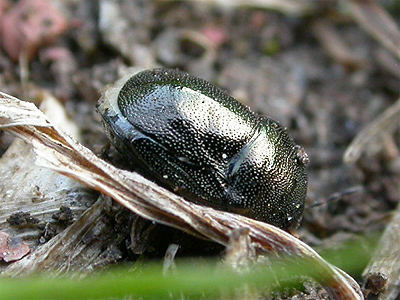 |
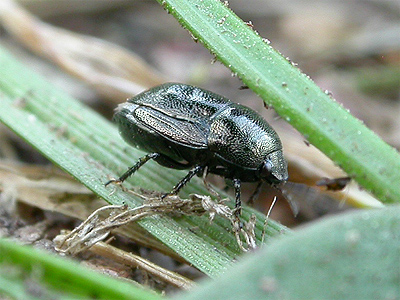 |
|